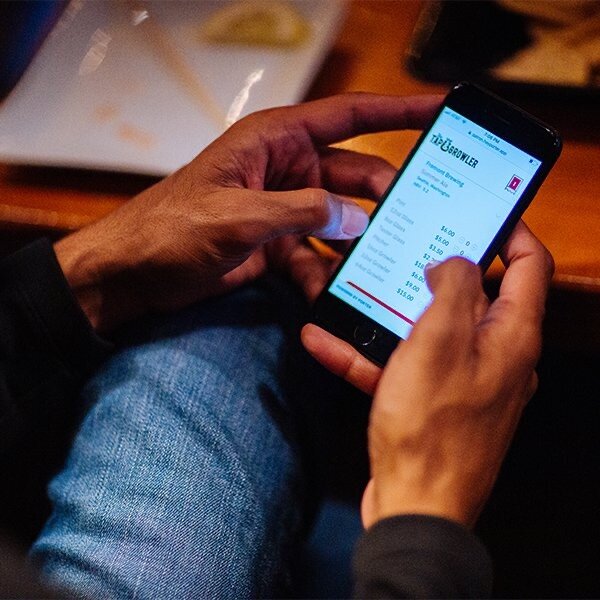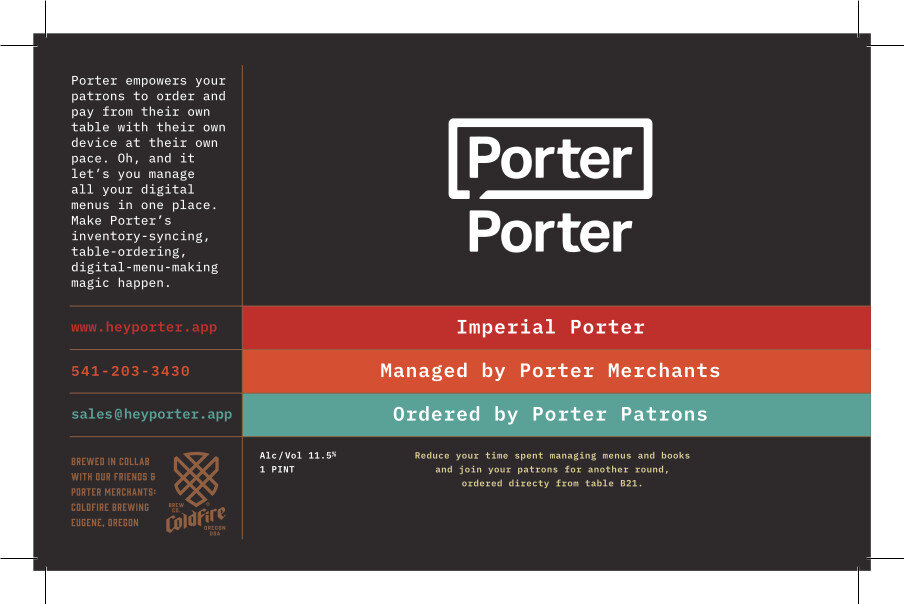'Porter' Adds Service Options for Pubs and Patrons

I walked into PublicHouse in Springfield, found a table, and sat down. Then, I did what I was most likely to do anyhow: I pulled out my phone. Rather than wait in line at the bar for a beer (I knew what I wanted) and then wait in another line for food, I went to PublicHouse’s website and clicked the Order Now! icon in the corner of the screen.
The next screen displayed all of the businesses operating under the old church roof; subsequent clicks led me to detailed menus, from which I selected my table number, beverage of choice in my size of choice (pint, obviously) and those tacos. A little receipt icon popped up in the corner of the screen, and I was able to see my tab and the price, and hit the button to place my order (a key step), with the option to tip as well as leave the tab open or close it out. The beer arrived after a few minutes; the food a few minutes after that. And I kept my seat warm the whole time.
The Beginning
This order of operations was brought to me by Porter. The appropriately named online app launched recently, and is the brainchild of Colby Phillips and Patric Campbell, the founders of a trio of Eugene/Springfield craft beer bars, and Eugene-based graphic designer Bryan Taylor. All three beer bars are counter-service joints, and two of the three have multiple food vendors that operate independently of the beer bars. The beer menus are displayed via projector at all three.
These mundane details add up to an inspiration. When opening Tap & Growler six years ago, Phillips had looked around for a beverage menu program that would work with projectors, but found none. Instead, he worked up an Excel file to track inventory that had to be manually translated to both the point-of-sale system and the digital menu board. “Now you’re inputting each one of your kegs four times. It’s inefficient and there’s more possibility for error. We felt like we could create a central database, so we decided to build our own. Bryan Taylor designed the menu boards. We thought ‘no one’s doing projected menu boards, we can monetize that.’”
They got distracted from the idea while opening Beergarden and PublicHouse, but that kernel of an idea did not stay dormant for long. In fact, it grew heartily enough to bust out of its flowerpot.
A system that combines front- and back-of-house operations plus online ordering and digital display control did not exist until now. There are some programs that do inventory and display, others that do online ordering, and POS systems that interface with kitchens and inventory management programs; none integrate with multiple vendors. But getting all of that in one box with point-of-sale integration was a challenge that Phillips felt called to tackle.
To help them climb this mountain, Phillips, Campbell, and Taylor found a sherpa in John Barry, a Eugene resident whose former life includes time on Capitol Hill and heading up international affairs for VISA. “I built a team of 30 people working around the world with different governments,” he states matter-of-factly. JB, as he is known, certainly has the experience to oversee the development and streamlining of such a complex program, and seems to have a zeal for tackling problems. His connection with Square, the popular mobile payment company, helped move the project forward as well. His business card reads “Chief Porter”; he is a co-founder and CEO of Porter.
The four main owners also hired Dave Merwin, web developer for Eugene-based Pure Blue Design, to round out the team.
“My biggest challenge," says JB, "was that the idea that led to Porter was such a rich idea. We really needed to focus on what’s the most valuable service to our client.”
Porter’s target client, says JB, is “the place that has counter service, a quickly rotating menu, and people who go for the on-site experience. Also, places with multiple vendors like food trucks.”
Counter service is unique to the Pacific Northwest, but becoming popular across the country. The oeuvre is known as “fast casual.” The idea of food halls is also growing fast – 300% per year, according to JB. Food halls, like at Portland’s Pine Street Market or Eugene’s 5th Street Market, maximize urban real estate and provide an anchor for that location.
After over a year in development, Porter was quietly implemented at Tap & Growler on July 15, 2019. Fliers at each table explain the ordering process, and offer a customer comment section. Many of the first comments included notes about bugs in the program, which was exactly what the developers needed to hear. After working out the kinks, they moved Porter into Beergarden. Beergarden is a much more robust environment for Porter, as there are a handful of food trucks in addition to the bar, which means multiple ordering points for customers. By the time Porter went online at PublicHouse, most of the issues had been sorted out.

The Middle Man
“Nobody goes to Beergarden or PublicHouse to stand in line.” JB makes a good point, especially since one may spend time in two lines before settling into a seat.
Phillips adds, “This is just another opportunity to order. Our bartenders get to spend time with people who want to be at the bar.”
Kiefer VerSteegh, a veteran of Tap & Growler and former Sales and Brand manager for Monkless Belgian Ales, is now on the avant garde pitching Porter to potential patrons as Sales Manager. From his perspective, there are advantages for both the business and the customer. “There’s a specific benefit, for example, for families who come in and order from multiple places. Or business people who don’t have the time to spend in line. For prospective clients coming from beer backgrounds, having one program that updates your menus and syncs with the POS is going to be valuable.”
Though its use is not widespread enough for a full evaluation, the team has also seen Porter make life easier for servers. “The time spent serving at the bar is equal to filling an order [through Porter],” says Phillips. “It lets bartenders focus on the people who want to talk to them. At all three locations, tips have increased 12%. We think it’s because customers feel like they’re getting more service.”
JB cites an instance where a family came in for a meal at Beergarden, saw the new ordering option, and went for it. He asked the father about his experience with Porter. The father said, “it was a game changer; we would normally spend more time in line than sitting down.”

Behind the Scenes
It’s hard to argue the convenience Porter provides. It should be noted, though, that the service is not free. A fee amounting to a small percentage of the tab, around $1-2, is added on; that’s what keeps Porter afloat. Keep in mind that using Porter is not mandatory, either for the customer or the vendor. It is, simply, an option. Phillips notes that it is most often used during the busiest times of day; no surprise there.
Vendors who sign on pay a small monthly fee, and may have to upgrade or purchase a tablet. Porter also integrates with receipt and kitchen printers. “We’re trying to eliminate hardware purchases as much as possible,” says VerSteegh. Having an account with Square is not necessary, but has advantages when it comes to keeping track of sales made through Porter.
When an order comes through, it is placed in a queue that is visible on the register screen. Of course, orders for each vendor are kept separate; the bar does not see food truck orders. Once an order comes in, a timer starts. These timers are customizable by each business. For PublicHouse, the timer at the bar glows green until the two-and-a-half-minute mark, when it turns yellow, and then red after five minutes. Once an order is filled, the bartender marks the order as such and the timer stops. Bartenders there are instructed to keep a mental queue to avoid too much “cutting in line” by Porter orders.
So far, there has been no need for additional staff to support Porter orders. Rather than spending x amount of time interacting with a customer, an online order can be quickly dealt with. Indeed, on busy nights, beer may arrive at the table faster than if the customer stood in line. However, those who wish to taste a couple beers before deciding must belly up in real life.
The Wonders of Modern Technology
Beer may be the most consistently analog food product in the world. Sure, there are automated breweries, but there is no substitute for mashing, boiling, hopping, and fermenting with our favorite four (or so) ingredients. Getting a beer is also, historically, analog. Go to a pub, talk to the bartender, maybe taste some beers and have a conversation, and watch as your bartender pours your beer. Pay, tip nicely. But these are different times; there are pubs popping up across the country that allow you to pour your own beer. And now, there is Porter.
To be honest, the thing that struck me the most was Porter’s full embrace of 21st century social life. At nearly every turn, it disassembles and reassembles what it means to go out to eat, either as an individual or in a group. Rather than shake its fist at people who sit down together and take out their phones, it anticipates—no, it encourages—the habit. All of the thought put in to the back end and design has resulted in a very intuitive ordering experience that increases accessibility and convenience for the customer, and enhances visibility for participating businesses.
As part of its sales outreach effort, Porter teamed up with ColdFire Brewing for a special can of beer. Porter Porter is an 11.5% abv imperial porter, labeled with Porter's graphics and info. Some of the beer will be available on draught at the three beer bars, though the cans will not be sold to the public.

More information about Porter can be found at heyporter.app

